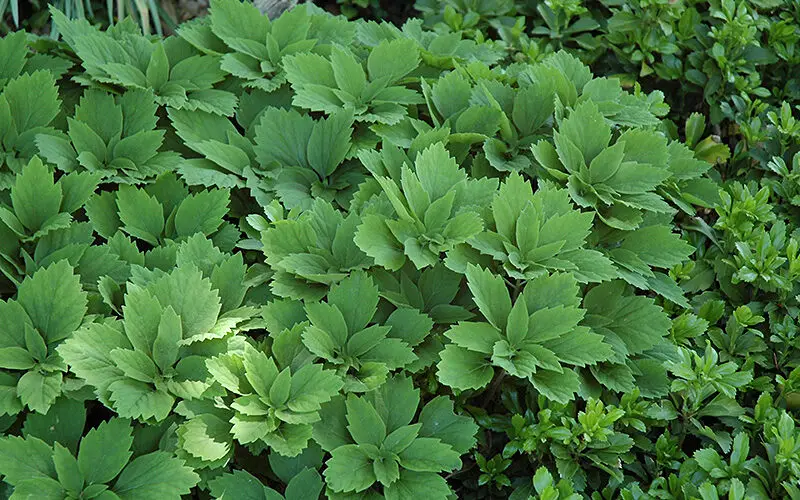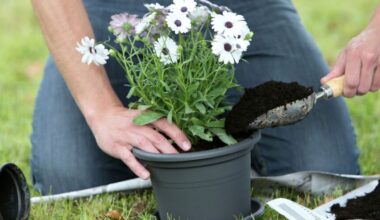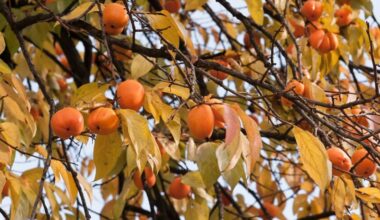Pachysandra terminalis is a perennial with a tapering habit. This small shrub, close to boxwood, is very hardy, so it can be grown in the garden at any time of the year. Pachysandra is grown for its beautiful foliage which makes it an excellent ground cover in shady areas.
The foliage is a shiny dark green with a silver edge. The evergreen leaves, 2 to 4 inches long, are oval, toothed at the tips. They are grouped in clusters at the end of short branches.
The stump is stoloniferous, meaning that it has a creeping stem on the ground that produces new plants. It is rather little tracing. At maturity, this perennial can reach 12 inches in height with a 20 inch spread. The Japanese Pachysandra gives in June small white male flowers, gathered in 1 inch long spikes at the end of the stems.
They are slightly perfumed and appear on the shoots of previous years. The female flowers remain under the foliage and sometimes give birth to large white fruits. It is a plant which takes its time to spread.
Contents
Planting the pachysandra
Where to plant it?
An ordinary soil is suitable for this undemanding perennial. In a humus soil which remains rather fresh in summer the plant grows better.
A shady exposure is recommended, the pachysandra grows very well in places that do not receive direct sunlight. It likes under a cover of trees or shrubs, but also at the edge of a path in the places a little more luminous. On the other hand, the exposure to the burning sun is not recommended, and the plant does not like the great heat of the south of France. When installing the plant in direct exposure, cloudy areas are more appropriate.
When to plant the pachysandra?
Spring and fall are the two periods for planting perennials, resulting in a better recovery either before the summer heat or before the winter cold.
If you plant in autumn, do it early enough, before the first frosts as the plant is persistent, and in spring, wait until the frosts have passed.
How to plant the pacasandra?
Pachasandra is easy to plant in the spring from stumps or divisions. Space each plant 6 to 13 inches apart to allow them to spread. This plant prefers moist soil amended with rich organic matter. Before installing your pachysandra in the ground, clean the planting area by removing debris. Take the time to loosen the soil to ensure a good recovery for the plant.
The planting hole for the pachysandra should be 4 inches deep and 6 inches wide. Be careful not to choose a location that is too sunny! Indeed, the leaves of the pachysandra burn easily. It is always best to plant it in overcast, shady or semi-shaded areas. Water the new plants thoroughly and place 2 inches of mulch to keep the soil cool.
Growing and caring for Pachysandra
Continue regular watering for the first two years of planting to help the pachysandra take hold and promote spreading. Installing a perforated hose that snakes between the feet and connected to a timer makes it easier to water afterwards. Be careful, if you install this system at the beginning, place the pipe close enough to each foot so that none is damaged. Check the freshness of the soil regularly.
Mulch the soil between the plants the first year with an organic mulch. You will then let this mulch decompose under the foliage of the ground cover. Mulching keeps the soil cool and prevents volunteer plants from growing. But don’t mulch the second year, to let the pachysandra multiply. It covers the soil so well afterwards that weeds will not grow.
Add some leaf compost if the soil is very poor, especially at the base of large trees.
No maintenance is required afterwards, apart from watering when the weather is dry. If the plant grows too large, remove some of the stalks and replant them elsewhere.
Uses: ground cover, slope, border…
Pachysandra terminalis can be placed at the foot of fresh ground perennials, such as white astilbe. It retains the humidity of the soil and limits the growth of weeds, often difficult to pull out between the plants of a bed. In a cool corner, it is a good alternative to ivy or periwinkle, both more traditional.
It is also used to form a chic and elegant carpet in undergrowth, at the foot of tall trees or between shrubs. Combine it with spring-flowering bulbs such as snowdrops, hyacinths, muscarias and daffodils, in the company of lovely epimediums.
You can also plant the pachysandra on a shaded slope, to limit the maintenance, and along a shaded path or wall of the house with the Caucasian forget-me-not.
Grown in a pot, it can be used to green up a shaded yard.
Growth of the pacasandra
Pachysandra terminalis spreads easily in the garden thanks to its rhizomes, roots rather little tracing which allow a rather slow expansion of the plant. It is not an invasive plant. Allow 3 years to see it fully occupy the surface.
Another advantage, its expansion allows it to take the place of weeds. This tapestry plant thus acts as a living mulch.
Multiplication of the pacasandra
You can divide the clumps in spring.
Simply take some feet with their root ball by digging around it with a small spade. Replant immediately in a place protected from direct sunlight.
Pacasandra pests and diseases
Once well rooted, the Pachysandra knows no particular enemy. Only slugs and snails threaten its young foliage when it is established.









